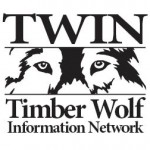Hiding under the covers, dressed in grandma’s nightgown with long, white teeth glinting in the moonlight. Huffing and puffing and blowing down poor little pigs’ houses. Dressing up in a coat of sheep-skin to lull a shepherd and prey on his flock. These are images of the lone wolf in children’s books.
But what about the real, endangered wolves of the wild? Wolves live in family groups, often with a breeding pair, pups, older brothers and sisters, and sometimes other unrelated adults. Pack life offers the adults more opportunities to hunt, and the youngsters more sources of care and food.
Even in the relative safety of zoos, each pack member may serve a function within the group, such as food-provider, pup-entertainer or disciplinarian. So while the parents are the leaders, other members also contribute. Such teamwork is possible only with plenty of communication.
Welcome to wolf posturing.
Imagine that you are a gray or red wolf pup. Hungry? Need to grab the attention of mom, dad, aunts or uncles? Just lick their muzzles; you’ll soothe the adults and may be rewarded with a regurgitated meaty snack.
You can assert yourself by raising your tail, pricking up your ears and standing tall. Overdo it, though, and the adults will check you with bared teeth, low growls, nips or a bite hold. But don’t despair. You can head off conflict by lowering your tail, tucking back your ears or rolling on your back in a submissive pose.
Wolves communicate with growls, whines, yips and yaps, barks and howls in different pitches and volumes. Wild wolves spontaneously howl most often to reconnect with separated pack members or to kick off a hunting trip. For wolves in zoos, howling is also sometimes triggered by external sources, such as emergency sirens.
And don’t forget the super-sniffers. According to researchers with the Red Wolf Recovery Project, red wolves mark or “fence off” their territory with odiferous urine and scat, just like our dogs on a walk at home. Pack members recognize their own smelly signatures and also when they have wandered into another pack’s domain – important for keeping the peace.
For critically endangered red wolves, cooperative parenting is also an important factor in the species’ repopulation throughout the Alligator River National Wildlife Refuge area in North Carolina. In a technique called cross-fostering, biologists take one or two pups born in protected breeding facilities and add them to wild dens for rearing by their surrogate parents. Thanks in part to the animals’ social nature, wild red wolves accept these zoo-born pups into their own litters, helping to grow their numbers from a low of 14 in 1980 to about 100 in the wild today. That is a real image of pack power.
Test your wolf nose
Wolves learn a lot about their environment through their sense of smell. Is your nose up to the challenge? Try this smelly identification game to find out:
You will need:
• Small containers with lids, such as old film canisters, empty spice shakers or other recycled food containers. If your containers are see-through, cover them by wrapping the bodies and lids with colored tissue paper, construction paper or paper towel pieces and secure with tape.
• Pen or other pointy object to punch holes in your container lids
• Interesting, fragrant materials from around the house (coffee beans or grounds, soap, fruit, chocolate, vinegar, crayons, cinnamon and more)
Carefully punch a few holes into the lids of the containers. (You will sniff through these.) Put small amounts of different fragrant materials in the containers and cover tightly. Take turns sniffing the contents, closing your eyes to make it harder. How many things can you correctly identify?
Learn more about wolves
Visit Point Defiance Zoo & Aquarium to see red wolf parents “Graham” and “Millie” with their pups.
Visit these websites:
fws.gov/redwolf
kids.nationalgeographic.com/kids/animals/creaturefeature/graywolf
pdza.org
wolfhaven.org
